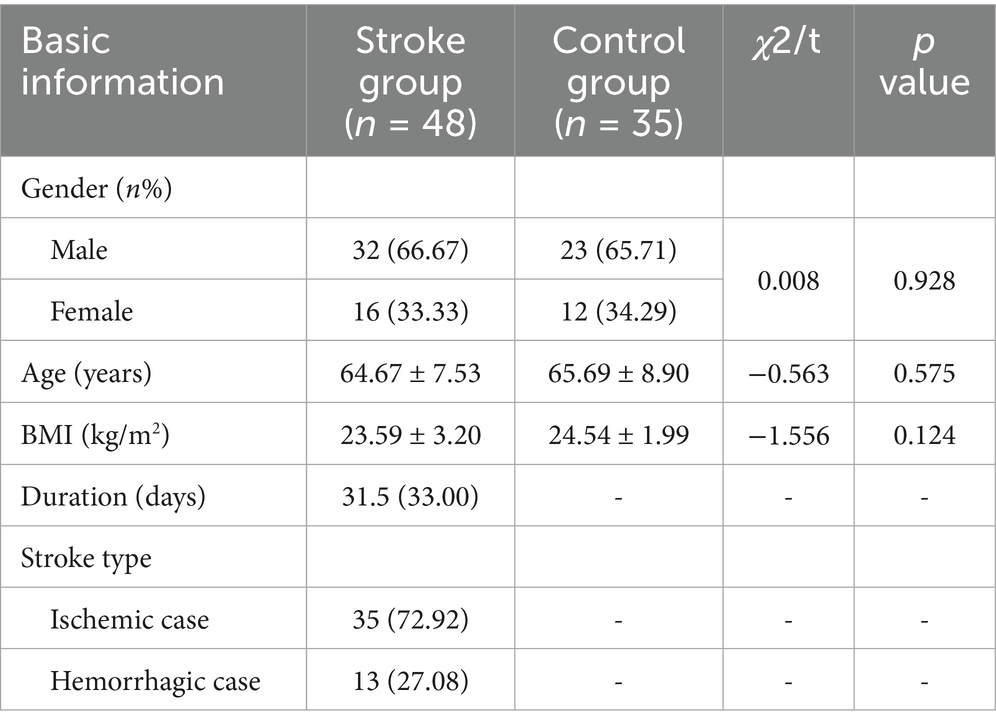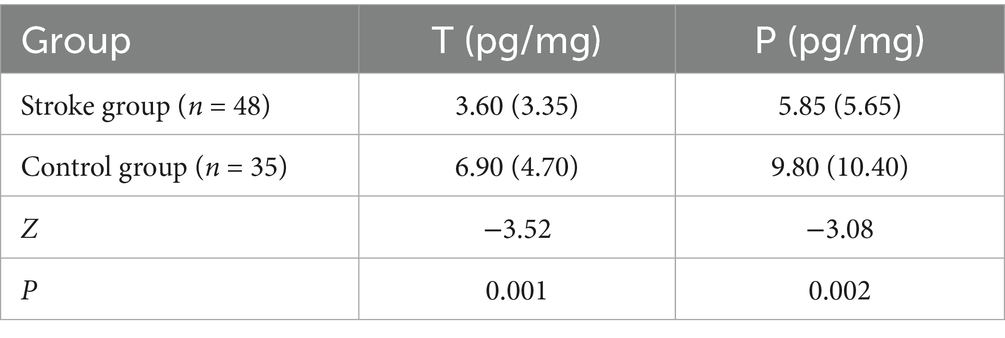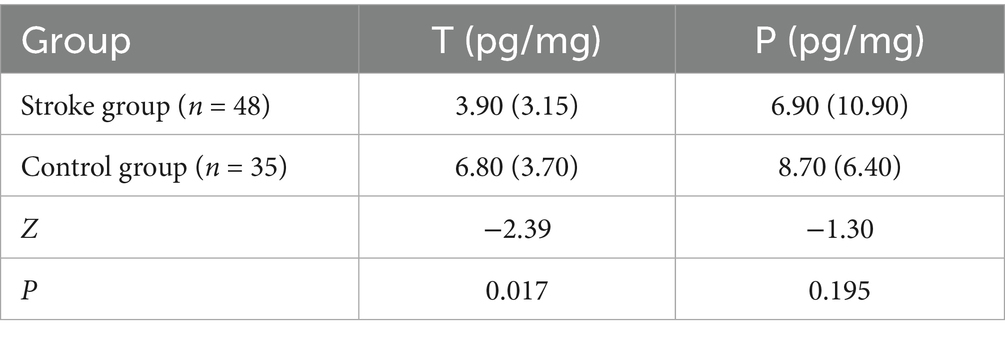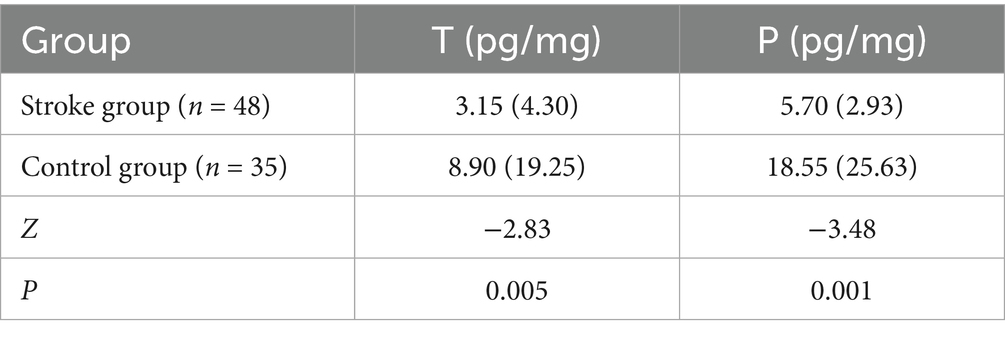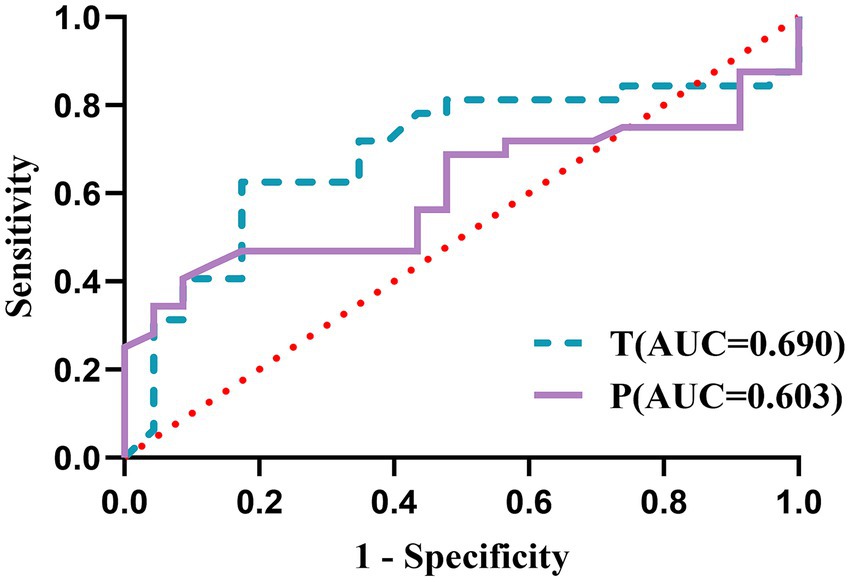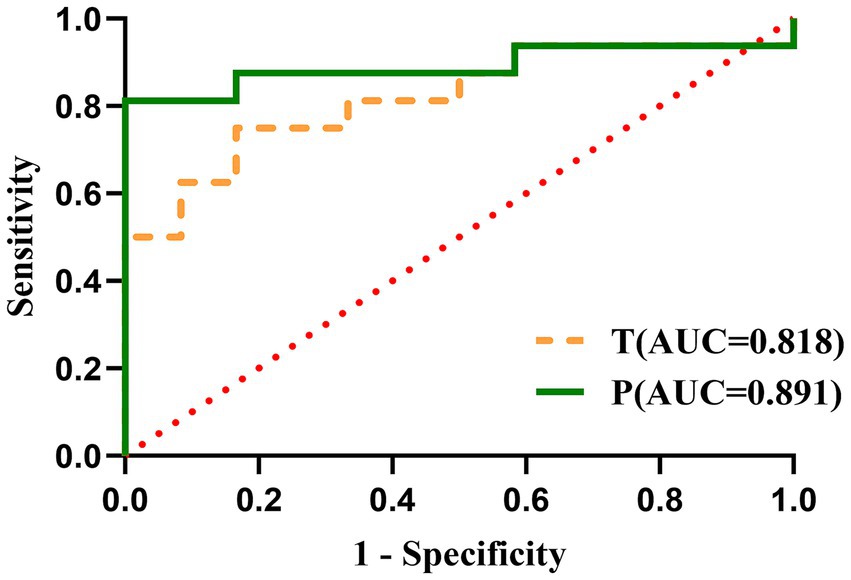- 1Rehabilitation Center, The First Affiliated Hospital with Nanjing Medical University, Nanjing, China
- 2School of Biological Science and Medical Engineering, Southeast University, Nanjing, China
- 3Department of Rehabilitation Medicine, The Eighth Affiliated Hospital of Southern Medical University (The First People’s Hospital of Shunde Foshan), Foshan, China
Background: There have been many studies on the relationship between sex hormones and stress, mood, blood pressure, etc., but its impact on the incidence of stroke remains unknown.
Objective: To investigate the expression levels of hypothalamic–pituitary-gonadal (HPG) axis related hormones such as testosterone (T) and progesterone (P) in hair before stroke and their effects on the risk of stroke.
Methods: 48 patients with stroke were recruited from November 2022 to May 2023 as the observation group and 35 healthy subjects were recruited as the control group. There was no obvious difference in age, gender and BMI between the two groups (p > 0.05). T and P levels in hair were tested by LC-MS/MS, and the correlation with the risk of stroke was analyzed.
Results: The T and P levels of hair before the onset of stroke in the observation group were significantly lower than those in the control group (p < 0.01). The T level of men’s hair before the onset of stroke in the observation group was significantly lower than those in the control group (p < 0.05). The T and P levels of women’s hair before the onset of stroke in the observation group were significantly lower than those in the control group (p < 0.01). The results of ROC curve showed that the cut-off value of T level in men’s hair before the onset of stroke was 4.35 pg/mg, the AUC was 0.690 (0.545, 0.835), the sensitivity was 62.50%, and the specificity was 82.61%. The cut-off value of T level in women’s hair before the onset of stroke was 5.00 pg/mg, the AUC was 0.818 (0.658, 0.978), the sensitivity was 75.00%, and the specificity was 83.33%. The cut-off value of P level in women’s hair before the onset of stroke was 8.00 pg/mg, the AUC was 0.891 (0.754, 1.000), the sensitivity was 81.25%, and the specificity was 100.00%.
Conclusion: This preliminary report is the first to suggest that HPG axis hormones such as T and P in hair could have predictive value in screening for stroke risk.
1 Introduction
Cerebrovascular diseases have now ascended to the foremost cause of mortality in China, with stroke constituting the single most prevalent etiology of disability, exerting a substantial burden on both individuals and society (1). Stroke is a preventable and manageable disease, and early screening combined with active intervention can markedly enhance patient prognosis (2).
Emerging evidence suggests associations between hypothalamic–pituitary-gonadal (HPG) axis hormones including testosterone (T), estradiol (E2), and progesterone (P) and stroke incidence (3, 4). Haya et al. (5) conducted a 29-year follow-up study involving 4,615 adult males and 4,724 adult females to investigate endogenous hormone profiles, revealing that extremely low serum T concentrations were significantly associated with elevated ischemic stroke risk in males. However, this study faced methodological limitations, including the absence of precise temporal data on stroke onset in community-based populations, which has led to the need for studies in larger samples. Furthermore, the requirement for continuous serological monitoring and extended follow-up until stroke occurrence resulted in prolonged study duration, substantial costs, and potential confounding from unadjusted variables such as aging.
Hormone levels in human hair serve as endogenous biomarkers for retrospective assessment of hypothalamic–pituitary-adrenocortical (HPA) and HPG axis activity (6). The measurement of hormone levels in hair is retrospective, with 1 cm of hair corresponding to approximately 1 month of hormonal accumulation, and a reliable retrospective window extending up to 6 months (7). Compared to traditional biological matrices such as blood, serum, and urine, hair hormone analysis offers distinct advantages, including cumulative representation of long-term exposure, non-invasive sampling, and the ability to reflect baseline levels over extended periods (similar to how hemoglobin A1c is used to assess serum glucose levels) (7–9). While clinical studies on hair hormones have proliferated (10, 11), current research predominantly focuses on associations between hair hormone levels and psychiatric, emotional, and sleep-related disorders. For instance, Wright et al. (12) demonstrated in a systematic review that cortisol quantification in hair can evaluate chronic stress exposure in elderly populations. Deng et al. (11) investigated functional characteristics of the HPA and HPG axes, as well as their interplay, in patients with schizophrenia by analyzing expression levels of eight biomarkers in hair samples. Similarly, Wang et al. (13) identified a significant correlation between pre-onset HPA axis hyperactivity and post-stroke emotional disorders.
Current research lacks substantial evidence on the correlation between pre-stroke HPG axis hormone levels in hair and stroke risk. Considering the influence of age and sex on HPG axis activity (14), this study investigates the relationship between the expression levels of HPG axis hormones in the hair and the risk of stroke onset among individuals aged over 50, across different genders. The findings aim to provide novel insights and methodologies for early stroke screening and intervention strategies.
2 Materials and methods
This study was reviewed and approved by the Ethics Committee of Jiangsu Provincial People’s Hospital (2022-SR-553), and was prospectively registered with the Chinese Clinical Trial Registry (ChiCTR2200065803). All participants provided written informed consent to participate in the study.
2.1 Participants
Study participants included 48 stroke patients (32 males, 16 females) hospitalized at Jiangsu Provincial People’s Hospital and its Qixia Rehabilitation Branch between November 2022 and May 2023. Subjects in the stroke group had a mean age of 64.67 ± 7.53 years, with a mean disease duration of 31.50 days (IQR 33.00). Stroke group included 35 ischemic and 13 hemorrhagic cases. A control group of 35 healthy individuals (23 males, 12 females; mean age 65.69 ± 8.90 years) was recruited. No statistically significant differences were observed between groups in age, sex, or body mass index (BMI) (p > 0.05) (Table 1).
Inclusion Criteria for Stroke Group were as follows: ① Age 50–80 years; ➁ Stroke diagnosis confirmed by neuroimaging and compliant with diagnostic guidelines established by the Chinese Stroke Society; ➂ First-ever unilateral stroke; ➃ Disease duration ≤ 3 months; ➄ Clinically stable with vital signs within normal ranges; ➅ Postmenopausal status (confirmed by amenorrhea ≥ 12 months) for female participants.
Inclusion Criteria for Control Group were as follows: ① Age 50–80 years; ➁ No history of stroke or major neurological disorders; ➂ Postmenopausal status for female participants.
Exclusion Criteria (Both Groups) were as follows: ① Auditory comprehension deficits or inability to follow verbal commands; ➁ Concurrent with other central nervous system lesions (e.g., traumatic brain injury, brain neoplasms); ➂ History of reproductive system disorders or surgeries; ➃ Substance abuse, hormone therapy within the past year, or chronic alcoholism; ➄ Occipital hair length < 3 cm; ➅ Recent hair treatments affecting analysis.
2.2 Sample collection
Hair samples were collected from all subjects on their enrollment day. Hair samples were collected by cutting 1 cm of hair from the occipital region, located at the back of the subject’s head near the scalp. Specimens were wrapped in aluminum foil, labeled, and stored at room temperature protected from light.
2.3 Hormonal analysis
Hormonal concentrations in hair were analyzed via high-performance liquid chromatography–tandem mass spectrometry (LC-MS/MS), where an Agilent 1,200 liquid chromatograph (Agilent Technologies, Inc., United States) was combined with an API 3200 Q-TRAP mass spectrometer (Applied Biosystems, Inc., United States), following a previously developed method (15). Hair samples corresponding to the period before the onset of lesions were selected based on the disease course (If the duration of the patient’s disease is 30 days at the time of admission, the 1 cm of hair closest to the scalp is the total amount of hormones accumulated in the hair in the month when the stroke occurred, and the 2 cm close to the scalp is the total amount of hormones accumulated in the hair in the month before the stroke occurred). Hair samples were rinsed with 5 mL of methanol for 2 min, and then heated to 50°C for drying. In a 2 mL centrifuge tube, hair samples were weighed after measuring 1–2 mm in length and cut into powder. After incubation in methanol for 24 h at 25°C, the mixture was centrifuged at 1.2 × 104 r/min for 5 min. Transfer 800 μL of supernatant into another clean centrifuge tube and evaporate nitrogen at 40°C. The residue was then redissolved in 50 mL of mobile phase for LC-MS/MS analysis.
There was good performance, with limits of detection and quantification of 0.3 and 1.0 pg/mg for T, and 0.2 and 0.5 pg/mg for P, respectively. The recovery, intra-day, and inter-day coefficients of variation met the requirements. Analyses were conducted at the Jiangsu Provincial Key Laboratory of Biomaterials and Devices, Southeast University.
2.4 Statistical analysis
SPSS 25.0 software was used for data analysis. Normality of continuous variables was assessed via the Shapiro–Wilk test. Normally distributed data are presented as mean ± standard deviation, while non-normally distributed data are expressed as median (interquartile range, IQR). Group comparisons for normally distributed continuous variables utilized independent samples t-tests, whereas non-parametric Mann–Whitney U tests were applied to non-normally distributed data. Receiver operating characteristic (ROC) curve analysis was conducted to evaluate the predictive efficacy and the cutoff values of T and P for stroke risk. Categorical variables are reported as frequencies and percentages, with between-group comparisons performed using chi-square tests. A two-tailed p < 0.05 was considered statistically significant.
3 Results
3.1 Comparison of T and P expression levels between the two groups
The T and P levels of hair before the onset of stroke were significantly lower in the stroke group compared to the healthy control group (T: 3.60 vs. 6.90 pg/mg, Z = −3.52, p = 0.001; P: 5.85 vs. 9.80 pg/mg, Z = −3.08, p = 0.002). The median reductions in T and P levels were 48% and 40%, respectively (Table 2).
3.2 Comparison of T and P expression levels in men between the two groups
Among male subjects, the T and P levels of hair before the onset of stroke were lower in the stroke group than in the control group. T levels were significantly reduced in the stroke group (3.90 vs. 6.80 pg/mg, Z = −2.39, p = 0.017), representing a 43% reduction. Although P levels were lower in the stroke group (6.90 vs. 8.70 pg/mg), this difference was not statistically significant (p = 0.195) (Table 3).
3.3 Comparison of T and P expression levels in women between the two groups
Among female subjects, the T and P levels of hair before the onset of stroke were significantly lower in the stroke group than in the control group (T: 4.00 vs. 7.10 pg/mg, Z = −2.83, p = 0.005; P: 3.95 vs. 8.60 pg/mg, Z = −3.48, p < 0.001). The median reductions were 44% for T and 54% for P. The reduction in P was particularly pronounced and demonstrated higher statistical significance (p < 0.001) compared to T (p = 0.005) (Table 4).
3.4 ROC analysis of HPG axis hormones in stroke onset prediction
The results of ROC curve showed that the cut-off value of T level in men’s hair before the onset of stroke was 4.35 pg/mg, the area under the curve (AUC) was 0.690 (0.545, 0.835), the sensitivity was 62.50%, and the specificity was 82.61%. The cut-off value of T level in women’s hair before the onset of stroke was 5.00 pg/mg, the AUC was 0.818 (0.658, 0.978), the sensitivity was 75.00%, and the specificity was 83.33%. The cut-off value of P level in women’s hair before the onset of stroke was 8.00 pg/mg, the AUC was 0.891 (0.754, 1.000), the sensitivity was 81.25%, and the specificity was 100.00% (Table 5; Figures 1, 2).
4 Discussion
Existing studies (5, 16) indicate that the mean age of onset for ischemic stroke is 57 years in males and 59 years in females. Given the sharp decline in P levels among women after age 40 and significant fluctuations in T levels in men beyond 80 years, this study restricted enrollment to participants aged 50–80 years to reduce confounding effects.
Our findings demonstrate significantly lower pre-stroke hair T and P levels in the stroke cohort compared to healthy controls (p < 0.05), suggesting potential predictive utility of HPG axis hormones for stroke risk. This aligns with prior research: Kloner et al. (17) found in their review that low T levels increase the risk of cardiovascular and cerebrovascular diseases, while Molenberg et al. (18) employed Mendelian randomization to establish associations between HPG axis dysregulation and aneurysmal subarachnoid hemorrhage. Therefore, detecting the expression levels of HPG axis hormones may have a certain indicative effect on the risk of stroke onset.
Considering that the HPG axis hormone level is greatly affected by gender (16), T and P levels were analyzed separately by gender. The results showed that male stroke patients had significantly lower pre-stroke hair T levels compared to healthy controls (p < 0.05), whereas female stroke patients exhibited significantly lower pre-stroke hair T and P levels (p < 0.05). This suggests that T levels may predict stroke risk in males, while both T and P levels are predictive in females.
In males, T levels decline with age (17). Ho et al. (19) demonstrated that low T levels correlate with reduced survival rates, and males with low T levels at admission exhibiting higher mortality rates. Which potentially mediated by T’s neuroprotective roles in mitigating oxidative stress, enhancing cerebral antioxidant capacity, and inhibiting neuronal apoptosis (4). Yeap et al. (20) identified T as an independent predictor of stroke in males, with low dihydrotestosterone (DHT) also serving as an independent risk factor. However, serum-based hormone measurements in these studies are prone to daily-life confounders, limiting their clinical utility for establishing reliable cutoff values. Our research findings are consistent with their findings, and through ROC curve evaluation, we identified a T cutoff value of 4.35 pg/mg in male hair samples for stroke risk prediction, with an AUC of 0.690 (95% CI 0.545–0.835), sensitivity of 62.50%, and specificity of 82.61%. While testosterone replacement therapy (TRT) may improve low T levels in older patients, Loo et al. (21) identified that TRT in elderly males with low T levels may increase cardiovascular and cerebrovascular diseases, necessitating further investigation into endogenous versus exogenous hormone effects.
Epidemiological studies consistently demonstrate significant gender disparities in ischemic stroke incidence, with premenopausal females exhibiting markedly lower rates compared to age-matched males (22). This protective effect substantially diminishes following menopause, as evidenced by a pronounced increase in stroke incidence among postmenopausal females (22). Converging evidence from preclinical and clinical investigations indicates that exogenous progesterone administration confers significant neuroprotection (23–25). In experimental models, progesterone effectively reduces cerebral infarct volume and enhances functional recovery post-stroke (26). The neuroprotective mechanisms of progesterone appear multifaceted, potentially mediated through several key pathways: attenuation of inflammatory responses (27), preservation of blood–brain barrier (BBB) integrity (28), amelioration of mitochondrial dysfunction (29), mitigation of oxidative damage, and facilitation of myelin repair (30, 31). Collectively, these findings underscore progesterone’s substantial therapeutic potential as a cytoprotective agent for mitigating secondary brain injury and improving neurological outcomes after ischemic insult (24). However, no prior studies have examined pre-stroke P levels in relation to stroke risk. Our study identified significantly lower pre-stroke hair P levels in female stroke patients versus controls (p < 0.01), and identified a P cutoff value of 8.00 pg/mg in female hair samples for stroke risk prediction, with an AUC of 0.891 (95% CI 0.754–1.000), sensitivity of 81.25%, and specificity of 100.00%. At the same time, some studies (32) have shown that reduced E2 and P levels may not solely account for elevated stroke risk in women. The adverse effect of T on cardiovascular and cerebrovascular diseases, resulting in elevated testosterone-to-estradiol (T/E2) ratios may contribute to postmenopausal stroke incidence, which requires further research. Quantification of pre-stroke hair testosterone levels in female patients revealed significant disparities versus healthy controls (p < 0.01). And ROC curve analysis identified an optimal T cutoff of 5.00 pg/mg (AUC 0.818, 95% CI 0.658–0.978; sensitivity 75.00%, specificity 83.33%) for stroke risk stratification.
The analysis of hair HPG axis hormone levels offers unique advantages, including its cumulative nature, long-term retrospective assessment capacity, and non-invasiveness. Standardized detection methods based on LC–MS/MS can serve as a reference for clinical screening of high-risk stroke populations. This approach facilitates the detection of cryptogenic stroke and consequently contributes to improved patient outcomes. With future cost optimization and standardized implementation, hair hormone analysis holds promise as a valuable tool for primary stroke prevention.
4.1 Limitations
However, there are several limitations to this study. Due to technical limitations, the investigation focused solely on T and P; future studies ought to incorporate estradiol (E2), follicle-stimulating hormone (FSH), and DHT to further elucidate the impact of the HPG axis on stroke. As a pilot investigation, it was not feasible to comprehensively adjust for all confounding variables—including hypertension, dietary patterns, and physical activity levels—which will be rigorously accounted for in subsequent studies. The derived cut-off values for HPG-axis hormones in predicting stroke risk demonstrate potential clinical utility; however, their external validity requires rigorous verification through multicenter randomized controlled trials with larger cohorts.
5 Conclusion
In conclusion, this preliminary report is the first to suggest that HPG axis hormones such as T and P in hair could have predictive value in screening for stroke risk.
Data availability statement
The original contributions presented in the study are included in the article/Supplementary material, further inquiries can be directed to the corresponding authors.
Ethics statement
The studies involving humans were approved by the Ethics Committee of Jiangsu Provincial People’s Hospital (Approval number: 2022-SR-553). The studies were conducted in accordance with the local legislation and institutional requirements. The participants provided their written informed consent to participate in this study.
Author contributions
JY: Formal analysis, Writing – original draft. SL: Visualization, Writing – original draft. XL: Writing – original draft. TW: Data curation, Writing – original draft. HD: Resources, Writing – original draft. YJ: Methodology, Writing – original draft. DM: Conceptualization, Writing – review & editing.
Funding
The author(s) declare that financial support was received for the research and/or publication of this article. DM reports financial support was provided by the Key Research & Development Program of Jiangsu Province (grant no. BE2021012-4).
Conflict of interest
The authors declare that the research was conducted in the absence of any commercial or financial relationships that could be construed as a potential conflict of interest.
Generative AI statement
The authors declare that no Gen AI was used in the creation of this manuscript.
Any alternative text (alt text) provided alongside figures in this article has been generated by Frontiers with the support of artificial intelligence and reasonable efforts have been made to ensure accuracy, including review by the authors wherever possible. If you identify any issues, please contact us.
Publisher’s note
All claims expressed in this article are solely those of the authors and do not necessarily represent those of their affiliated organizations, or those of the publisher, the editors and the reviewers. Any product that may be evaluated in this article, or claim that may be made by its manufacturer, is not guaranteed or endorsed by the publisher.
Supplementary material
The Supplementary material for this article can be found online at: https://www.frontiersin.org/articles/10.3389/fneur.2025.1595429/full#supplementary-material
References
1. Saini, V, Guada, L, and Yavagal, DR. Global epidemiology of stroke and access to acute ischemic stroke interventions. Neurology. (2021) 97:S6–S16. doi: 10.1212/wnl.0000000000012781
2. Tu, WJ, and Wang, LD. China stroke surveillance report 2021. Mil Med Res. (2023) 10:33. doi: 10.1186/s40779-023-00463-x
3. Rexrode, KM, Madsen, TE, Yu, AYX, Carcel, C, Lichtman, JH, and Miller, EC. The impact of sex and gender on stroke. Circ Res. (2022) 130:512–28. doi: 10.1161/circresaha.121.319915
4. Huang, S, Liu, L, Tang, X, Xie, S, Li, X, Kang, X, et al. Research Progress on the role of hormones in ischemic stroke. Front Immunol. (2022) 13:1062977. doi: 10.3389/fimmu.2022.1062977
5. Holmegard, HN, Nordestgaard, BG, Jensen, GB, Tybjærg-Hansen, A, and Benn, M. Sex hormones and ischemic stroke: a prospective cohort study and Meta-analyses. J Clin Endocrinol Metab. (2016) 101:69–78. doi: 10.1210/jc.2015-2687
6. Xie, Q, Gao, W, Li, J, Qiao, T, Jin, J, Deng, H, et al. Correlation of cortisol in 1-cm hair segment with salivary cortisol in human: hair cortisol as an endogenous biomarker. Clin Chem Lab Med. (2011) 49:2013–9. doi: 10.1515/cclm.2011.706
7. Zhang, Q, Chen, Z, Chen, S, Yu, T, Wang, J, Wang, W, et al. Correlations of hair level with salivary level in cortisol and cortisone. Life Sci. (2018) 193:57–63. doi: 10.1016/j.lfs.2017.11.037
8. Russell, E, Koren, G, Rieder, M, and Van Uum, S. Hair cortisol as a biological marker of chronic stress: current status, future directions and unanswered questions. Psychoneuroendocrinology. (2012) 37:589–601. doi: 10.1016/j.psyneuen.2011.09.009
9. Hodes, A, Meyer, J, Lodish, MB, Stratakis, CA, and Zilbermint, M. Mini-review of hair cortisol concentration for evaluation of Cushing syndrome. Expert Rev Endocrinol Metab. (2018) 13:225–31. doi: 10.1080/17446651.2018.1517043
10. Jia, Y, Qi, D, Wang, T, Zhang, Y, Chen, X, Deng, H, et al. The role of pre-onset hair hormone in predicting the prognosis of patients with severe pneumonia and acute Covid-19 outbreak. Heliyon. (2024) 10:e30636. doi: 10.1016/j.heliyon.2024.e30636
11. Qi, D, Wang, W, Chu, L, Wu, Y, Wang, W, Zhu, M, et al. Associations of schizophrenia with the activities of the Hpa and Hpg axes and their interactions characterized by hair-based biomarkers. Psychoneuroendocrinology. (2024) 165:107049. doi: 10.1016/j.psyneuen.2024.107049
12. Wright, KD, Hickman, R, and Laudenslager, ML. Hair cortisol analysis: a promising biomarker of Hpa activation in older adults. Gerontologist. (2015) 55:S140–5. doi: 10.1093/geront/gnu174
13. Wang, T, Jia, Y, Qi, D, Deng, H, and Meng, D. Correlation analysis of hypothalamic-pituitary-adrenal axis hormone levels in hair before stroke onset and mood disorders after stroke. Rehabil Med. (2024) 34:211–6. doi: 10.3724/SP.J.1329.2024.03002
14. Rexrode, K. Sex differences in sex hormones, carotid atherosclerosis, and stroke. Circ Res. (2018) 122:17–9. doi: 10.1161/circresaha.117.312336
15. Voegel, CD, Baumgartner, MR, Kraemer, T, Wüst, S, and Binz, TM. Simultaneous quantification of steroid hormones and endocannabinoids (Ecs) in human hair using an automated supported liquid extraction (Sle) and Lc-Ms/Ms—insights into Ec baseline values and correlation to steroid concentrations. Talanta. (2021) 222:121499. doi: 10.1016/j.talanta.2020.121499
16. Lu, M, Li, Q, Weng, P, Zhu, C, Cao, C, and Lu, Y. Age-related natural change trend of important hormones in Chinese population. Chin J Endocrinol Metab. (2018) 7:555–62. doi: 10.3760/cma.j.issn.1000-6699.2018.07.005
17. Kloner, RA, Carson, C 3rd, Dobs, A, Kopecky, S, and Mohler, ER 3rd. Testosterone and cardiovascular disease. J Am Coll Cardiol. (2016) 67:545–57. doi: 10.1016/j.jacc.2015.12.005
18. Molenberg, R, Thio, CHL, Aalbers, MW, Uyttenboogaart, M, Larsson, SC, Bakker, MK, et al. Sex hormones and risk of aneurysmal subarachnoid hemorrhage: a mendelian randomization study. Stroke. (2022) 53:2870–5. doi: 10.1161/strokeaha.121.038035
19. Ho, CH, Wu, CC, Lee, MC, Huang, PH, Chen, JT, Liu, SP, et al. The Association of Serum Testosterone Levels with recurrence and mortality after acute ischemic stroke in males. Am J Mens Health. (2019) 13:1557988319847097. doi: 10.1177/1557988319847097
20. Yeap, BB. Testosterone and its metabolites: differential associations with cardiovascular and cerebrovascular events in men. Asian J Androl. (2018) 20:109–14. doi: 10.4103/aja.aja_50_17
21. Loo, SY, Azoulay, L, Nie, R, Dell'Aniello, S, Yu, OHY, and Renoux, C. Cardiovascular and cerebrovascular safety of testosterone replacement therapy among aging men with low testosterone levels: a cohort study. Am J Med. (2019) 132:1069–77. doi: 10.1016/j.amjmed.2019.03.022
22. Persky, RW, Turtzo, LC, and McCullough, LD. Stroke in women: disparities and outcomes. Curr Cardiol Rep. (2010) 12:6–13. doi: 10.1007/s11886-009-0080-2
23. Xu, J, Zhou, Y, Yan, C, Wang, X, Lou, J, Luo, Y, et al. Neurosteroids: a novel promise for the treatment of stroke and post-stroke complications. J Neurochem. (2022) 160:113–27. doi: 10.1111/jnc.15503
24. Guennoun, R. Progesterone in the brain: hormone, Neurosteroid and Neuroprotectant. Int J Mol Sci. (2020) 21:271. doi: 10.3390/ijms21155271
25. Yousuf, S, Atif, F, Espinosa-Garcia, C, Harris, W, Turan, N, and Stein, DG. Stroke-induced peripheral immune dysfunction in vitamin D-deficient conditions: modulation by progesterone and vitamin D. Mol Neurobiol. (2021) 58:950–63. doi: 10.1007/s12035-020-02129-4
26. Wali, B, Ishrat, T, Won, S, Stein, DG, and Sayeed, I. Progesterone in experimental permanent stroke: a dose-response and therapeutic time-window study. Brain. (2014) 137:486–502. doi: 10.1093/brain/awt319
27. Jiang, C, Cui, K, Wang, J, and He, Y. Microglia and Cyclooxygenase-2: possible therapeutic targets of progesterone for stroke. Int Immunopharmacol. (2011) 11:1925–31. doi: 10.1016/j.intimp.2011.08.001
28. Ishrat, T, Sayeed, I, Atif, F, Hua, F, and Stein, DG. Progesterone and Allopregnanolone attenuate blood-brain barrier dysfunction following permanent focal ischemia by regulating the expression of matrix metalloproteinases. Exp Neurol. (2010) 226:183–90. doi: 10.1016/j.expneurol.2010.08.023
29. Ozacmak, VH, and Sayan, H. The effects of 17beta estradiol, 17alpha estradiol and progesterone on oxidative stress biomarkers in Ovariectomized female rat brain subjected to global cerebral ischemia. Physiol Res. (2009) 58:909–12. doi: 10.33549/physiolres.931647
30. Schumacher, M, Sitruk-Ware, R, and De Nicola, AF. Progesterone and progestins: neuroprotection and myelin repair. Curr Opin Pharmacol. (2008) 8:740–6. doi: 10.1016/j.coph.2008.10.002
31. Vahidinia, Z, Karimian, M, and Joghataei, MT. Neurosteroids and their receptors in ischemic stroke: from molecular mechanisms to therapeutic opportunities. Pharmacol Res. (2020) 160:105163. doi: 10.1016/j.phrs.2020.105163
Keywords: stroke, hypothalamic–pituitary-gonadal axis, hormones, testosterone, progesterone
Citation: Yang J, Li S, Li X, Wang T, Deng H, Jia Y and Meng D (2025) Application of hair HPG axis hormone levels before onset in predicting the risk of stroke. Front. Neurol. 16:1595429. doi: 10.3389/fneur.2025.1595429
Edited by:
Donald Stein, Emory University, United StatesReviewed by:
Evgeniya Vladislavovna Pushchina, National Scientific Center of Marine Biology, RussiaDerek Schreihofer, University of North Texas Health Science Center, United States
Jinn-Rung Kuo, Chi Mei Medical Center, Taiwan
Fujian Xu, Fudan University, China
Copyright © 2025 Yang, Li, Li, Wang, Deng, Jia and Meng. This is an open-access article distributed under the terms of the Creative Commons Attribution License (CC BY). The use, distribution or reproduction in other forums is permitted, provided the original author(s) and the copyright owner(s) are credited and that the original publication in this journal is cited, in accordance with accepted academic practice. No use, distribution or reproduction is permitted which does not comply with these terms.
*Correspondence: Yuanyuan Jia, MTczMDkzMjc1M0BxcS5jb20=; Dianhuai Meng, ZGhkcmVhbUAxMjYuY29t
†These authors have contributed equally to this work and share first authorship
 Jiao Yang
Jiao Yang Shuhan Li
Shuhan Li Xuan Li1
Xuan Li1 Huihua Deng
Huihua Deng Yuanyuan Jia
Yuanyuan Jia Dianhuai Meng
Dianhuai Meng